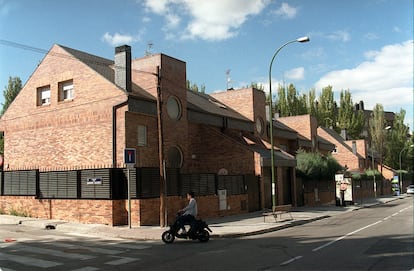Why living with no neighbors can be bad for your mental health
A Danish study reveals increased risk of depression when living in residential neighborhoods and stresses the importance of social relationships


Mental health can be influenced by an array of factors, and one of them is urban planning. The way towns and cities are arranged, along with the concentration of residential buildings can play a significant role in the risk of developing mental health disorders and diseases. A study conducted in Denmark, which was published on Wednesday in the Science Advances journal, has revealed that people living in urban suburbs are at greater risk of depression than those who live in urban centers or in rural areas. In the study, the researchers analyzed building density (the built-up area versus open space), building height, and diagnoses of depression between 1990 and 2018 (75,650 cases).
The authors observed that the lowest risk existed in rural areas and in parts of city centers with open spaces, which are decisive factors in enabling social interaction. Bumping into neighbors when you go to buy bread, the availability of plazas with benches where you can sit and chat, and parks to stroll through, with facilities for children to play in, all give people the chance to meet, according to epidemiologist Pedro Gullón, professor of public health at the University of Alcalá de Henares, in Spain.
Karen Chen, of Yale University and the study’s lead author, explains that the results of their work are not intended to discourage residential neighborhoods and terraced housing, but instead to explore how to make these areas more accessible to spaces conducive to socializing. “It is a question of improving walking activity, cycling and public transportation in areas that were initially automobile-centered,” she concludes.
Generally, residential neighborhoods tend to be areas with houses on the outskirts of cities, explains Gullón, and therefore it is not a question of a poorer standard of living. The epidemiologist, who did not participate in this investigation, argues that it comes down to the level of socialization: “It is an individualistic model [in residential areas] where there is practically no interaction between neighbors.” This trend can be related to a struggle to cope with daily problems and a decline in mental health.
The authors of the study also underscore the importance of this relationship between inhabitants to establish “a sense of community, reciprocity and trust (social capital).” These are factors that promote mental well-being and are protective against depression, the study highlights. However, if an area has a high density of buildings, but lacks open spaces, this can reduce sun exposure and increase indoor temperature. These are two environmental conditions that increase the risk of experiencing depressive symptoms, according to the study.
Chen points out that one of the things they have observed is that the best model is a combination of tall buildings with low density, which means more open space than buildings. The researcher argues that a certain level of density is required to create “animated communities” that can support commerce and public transportation and enable “restoration with the benefit of green spaces or water bodies.”
Social cohesion
The lower risk of depression in the rural environment can be attributed to the advantages it holds over the urban setting. These include lower stress levels and less noise, according to Gonzalo Martínez-Alés, a researcher at Harvard University’s CAUSALab. Additionally, it tends to allow its inhabitants to be closer to their loved ones, so it also provides social cohesion, continues the psychiatrist, who did not participate in the study either.
Nevertheless, Gullón and Martínez-Alés say that one of the weaknesses of the research is the way the concepts of urban, rural and suburban are defined: “It is complex, because they are relatively local definitions and it is not the same in one country as in another,” the psychiatrist explains. This, plus the idiosyncrasies of each place, creates difficulties in extrapolating the results to other countries, the experts say.
Even so, the epidemiologist stresses that a positive aspect of the study is the way they divided it into urban areas. According to Gullón, it is customary to refer to the urban area as a whole, but when we talk about cities, we are actually describing neighborhoods and situations that can vary greatly. “A city is not a homogeneous environment. There may be parts of a city where there is greater risk of mental health problems than in other areas,” he explains.
The professor from the University of Alcalá de Henares also emphasizes that in a country like Denmark, which boasts lower socioeconomic inequality, neighborhood influence on the lives of its inhabitants can be observed more clearly. In other countries, like Spain, things are much more complex because inequality is greater and the area of residence cannot be separated by the income level. Consequently, it is more difficult to “disentangle the effects produced by the physical characteristics of the neighborhood.”
Sign up for our weekly newsletter to get more English-language news coverage from EL PAÍS USA Edition
Tu suscripción se está usando en otro dispositivo
¿Quieres añadir otro usuario a tu suscripción?
Si continúas leyendo en este dispositivo, no se podrá leer en el otro.
FlechaTu suscripción se está usando en otro dispositivo y solo puedes acceder a EL PAÍS desde un dispositivo a la vez.
Si quieres compartir tu cuenta, cambia tu suscripción a la modalidad Premium, así podrás añadir otro usuario. Cada uno accederá con su propia cuenta de email, lo que os permitirá personalizar vuestra experiencia en EL PAÍS.
¿Tienes una suscripción de empresa? Accede aquí para contratar más cuentas.
En el caso de no saber quién está usando tu cuenta, te recomendamos cambiar tu contraseña aquí.
Si decides continuar compartiendo tu cuenta, este mensaje se mostrará en tu dispositivo y en el de la otra persona que está usando tu cuenta de forma indefinida, afectando a tu experiencia de lectura. Puedes consultar aquí los términos y condiciones de la suscripción digital.
More information
Últimas noticias
Trump claims peace in Ukraine is near, but Moscow suggests otherwise
A survivor’s account of the Interoceanic Train accident: ‘We were scared because of the speed on the curve’
The Interoceanic Train, the Mexican alternative to the Panama Canal
What is known about the Interoceanic Train derailment in Oaxaca
Most viewed
- Oona Chaplin: ‘I told James Cameron that I was living in a treehouse and starting a permaculture project with a friend’
- Reinhard Genzel, Nobel laureate in physics: ‘One-minute videos will never give you the truth’
- Why the price of coffee has skyrocketed: from Brazilian plantations to specialty coffee houses
- Pablo Escobar’s hippos: A serious environmental problem, 40 years on
- Chevy Chase, the beloved comedian who was a monster off camera: ‘Not everyone hated him, just the people who’ve worked with him’










































